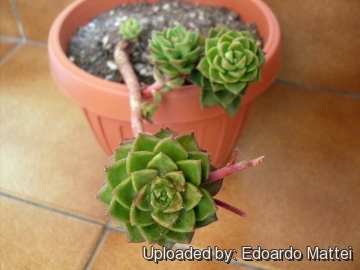




Your support is critical to our success.

Origin and Habitat: Garden origin (Nursery produced cultivar)
Synonyms:
RUSSIAN (Русский): Седиверия Летиция
Description: x Sedeveria cv. LetiziaSN|27660]]SN|27660]] is a beautiful interspecific hybrid between two different genera in the Crassulaceae family: Sedum cuspidatum and Echeveria setosa var ciliata. It produces small, clustering, very succulent rosette 5-6 cm across. The long, highly textured stems of 'Letizia', which develop slowly, are just like those of Sedum cuspidatum. As many succulents, colours change in seasons. During the winter the leaf-margins take a bright red-purple tinge enhanced by low temperature. Letizia was named for Letizia Alleruzzo (Italy).
Habit: It is a evergreen perennial succulent growing in mats because of the numerous "daughter" rosettes on long stolons which can be separated from the parents in spring, and grown separately - hence the common name "hen and chicks", applied to several species within the genus Echeveria . Mats can rich a height of 5–10 cm and a diameter of 50 cm.
Stems: Several branching from the base, diameter 3-12 mm, with cilia. Young stem with leaves, no leaves on the old stems.
Rosettes: Less than 6 cm across, with c. 22-50 , densely shingled leaves, and forming a symmetric Fibonacci spiral. Old leaves at the base of the rosette wither and fall off. New growth is from the centre of the rosette, so over time you get a denuded, awkwardly long stem with a rosette on the end
Leaves: 10-28 mm long, obovate-cuneate with mucro, entire, ciliate on the margin and the keel, green, margin becoming red in the sun.
Inflorescence: 1-3 cincinni with 5 or more flowers per cincinnus. Peduncle, pedicel and bract ciliate.
Flower: 5-merous; sepals free, equal; petals united for 1-1.5 mm, light rose in bud, white but very light rose in the sun, carinate (with keel) 8 mm long, 3 mm broad; stamens short with filament white at the base, light rose near the anther, anther yellow-light brown; carpel green, style white.
Note: x Sedeveria cv. Letizia is sometimes confused with Aeonium decorumSN|27266]]SN|27266]], but flowers are very different.

х Sedeveria cv. Letizia Photo by: Edoardo Mattei
The gallery now contains thousands of pictures, however it is possible to do even more. We are, of course, seeking photos of species not yet shown in the gallery but not only that, we are also looking for better pictures than those already present. Read More...
Cultivation and Propagation: x Sedeveria cv. Letizia is fairly easy, it can tolerate full sun (where it stay compact) but a better exposure is half-sun. It is always a favourite carefree windowsill citizen, an excellent addition to any garden.
Growth rate: This plant couldn't be described as vigorous, but can slowly form small mounds or carpets with time.
Exposition: Likes light shade to part sun (it will take a few hours of sun without a problem), but adapts very well to full sun and shade too. It can overwinters well also under grow lights in a cool room of the house. Sedeverias are chameleons. Those grown in partial shade tend to be green; in full, hot sun margins take a bright red colouring.
Soil: Although it needs a soil that is gritty and porous with good drainage, the soil must be able to hold the moisture that the plant requires. The ideal soil should contain equal parts of loam with small gravel added (eg pumice or lava grit). Good drainage is essential.
Watering: During the summer growing period the plant appears to need much more water than the average succulent. Water when plant is dry and do not water again until the soil is completely dry again. Dislikes over-watering. Pay particular attention to make sure that they do not rot at the root from soggy soil. During October to March, water very sparingly, using only enough water to keep the foliage from shriveling. In a very humid situation in winter, it can rot even if totally dry. It likes dry air as much as dry soil.
Fertilization: Fertilizer should be applied only once in early spring , diluted to ¼ the recommended rate on the label.
Hardiness: Although the plants will survive loght frost if kept dry they should be protected from frost to prevent scarring. It requires low temperature for flower formation and it will not flower unless it is overwintered for at least a month at 15° C or less. USDA zones 10-11.
Pests and diseases: No serious insect or disease problems. Watch for aphids and scale. Mealybugs infestations are also a frequent problem.
Human hazards: None.
Uses: A great plant for use as a groundcover, in gravel gardens, paved areas, rockeries, in hanging baskets or pots, or for spilling over walls. It is a bit brittle so avoid handling when possible and not for planting in areas with much traffic. Because the stems are so fragile, it is best to pick the best location for ghost plant and then don’t move it. Try mixing with other succulents and alpines.
Propagation: It is is propagated by the division of offshoots or by individual leaves, rooted in sand or in dry vermiculite. Any rosette that breaks off has the potential to root and start a new plant. Even a leaf that drops off will root below the parent plant and produce a new rosette quickly. Because leaves and cuttings root effortlessly, Sedeveria are among the easiest succulents to propagate.
| Your Actions | |
|---|---|
| Back to Sedeveria index | |
| Back to Crassulaceae index | |
 |
Back to Succulents Encyclopedia index |
Privacy stantement - Terms and conditions - How to cite - About us - Feedback - Donate



